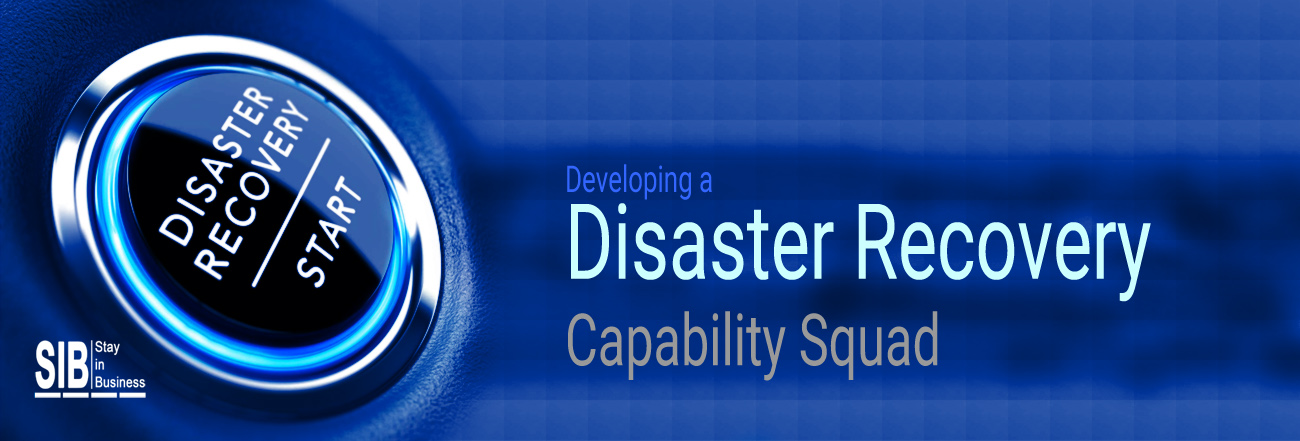Developing a DR Capability Squad

One of the biggest challenges for the proponents of disaster recovery in an organization is to convince leadership and senior management teams on why they must invest in a DR capability. Putting together a DR team is a collective effort that can’t be done in silos. It requires a lot of planning, key inputs from all strategic departments, financial backing and extensive training for employees who will execute the plans. Needless to say, the approval of the organization’s uppermost echelons goes a long way in cutting through administrative red tape and quickly provisioning a DR unit without unnecessary delays.
Leadership backing is also important to ensure that the best possible and most relevant disaster recovery initiative is adopted without sparing any expense or effort. The importance of a capable team of professionals who are well trained and have hands-on experience in such an undertaking can’t be emphasized enough. So the active participation of employees from different teams and departments, especially those who have served long tenures in the organizations should be encouraged from the very outset. This is because disaster recovery is a multidisciplinary venture that can impact everyone and everything involved directly or indirectly with the organization’s undertakings.
Such an approach also improves employee morale which in turn increases their involvement and consequently, productivity, as it sends a very assertive message about the organization’s intent to do everything in its capacity to stay operational and in business, even during the most adverse crisis scenarios.
Disaster Recovery – Focus Areas
- Counselling executive teams with data-driven insights on the best possible approach to building a business continuity capability that can failover operations during a disruption
- Overseeing the installation of the BC and DR capability and ensuring it is periodically updated and tested against new and emerging threats
- Obtaining a consensus from all key individual groups in the organization to actively support the initiative
- Taking ownership for the plan’s implementation during a crisis situation
Nearly every component in an organization’s operational environment could potentially lead to a disaster. That’s why BCDR initiatives require a multidisciplinary approach that involves key personnel from crucial sections of the company. Despite the most extensive research into a company’s historical data, one can never accurately forecast how a business disruption will impact the deliverables of different departments within an organization. Developing a business resilience model that equally addresses all concerns often leads to a conflict of interests between different departments over how the various DR objectives are prioritized. Besides, there are numerous interdependencies that also need to be taken into consideration while planning workaround alternatives.
It’s imperative that there is a healthy level of synergy between the efforts of different individuals in a multidisciplinary disaster recovery team, which can be achieved by:
- Broadly outlining the most important goals for business across all parameters such as data protection, brand reputation, financial & market liquidity, and so on
- Building a multidimensional response mechanism that addresses both internal threats that can be exploited by external entities, and external threats that can impact internal processes
- Sparing no expense in provisioning the right number and type of resources
Striking the Right Balance While Putting Together a Multidisciplinary DR Capability Team
The roles and responsibilities of different individuals must be clearly chalked out so that different personnel are accountable for the completion of specific tasks. The manner in which different tasks are grouped and delegated to the DR team members is largely a function of the scale at which the organization operates. Participants might also be challenged to improvise as many of the tasks could stretch their capabilities beyond their existing skill sets.
DR Capability – Responsibilities
- Spearheading all disaster recovery initiatives
- Sharing information internally within the organization and with external entities such as the press, media, customers, stakeholders and so on
- Efficiently utilizing available resources such as capital, assets, manpower, equipment, data, technology, and so on
- Nurturing cordial relations with third party entities such as vendors and providers
- Ensuring the health and safety of all staff members
- Protecting the business interests of the organization
Categories: Business Continuity, Disaster Recovery Planning, DR Plans
